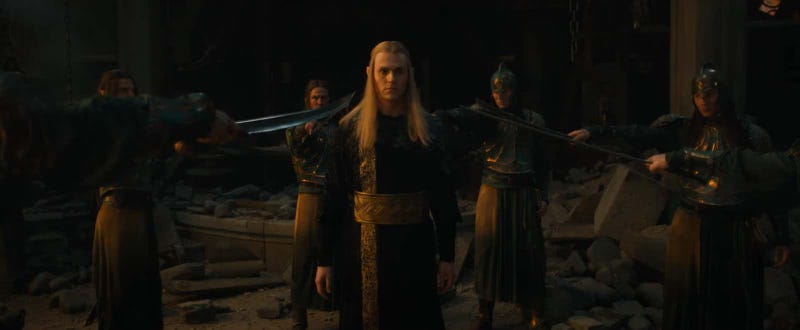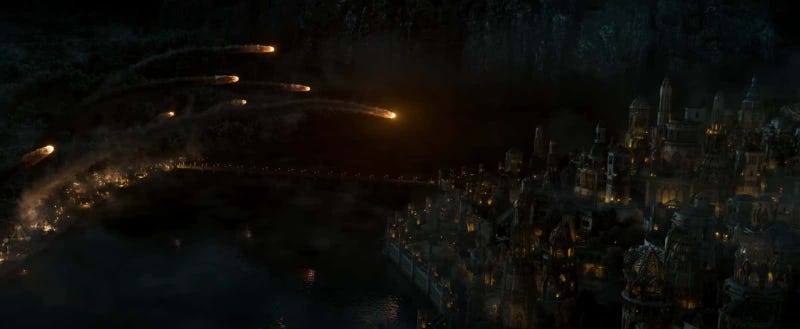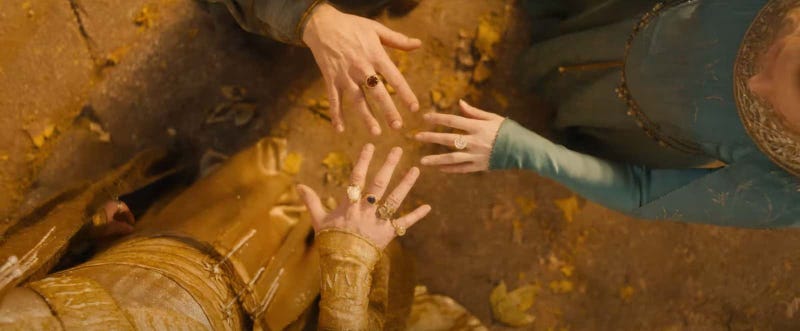When The Rings of Power returns this August, it’ll bring to life a climactic conflict that has long been a turning point in J.R.R. Tolkien’s Lord of the Rings chronology—not the battles of the final alliance to lay Sauron low, but the climactic war that set the stage for the rest of the Second Age.
The War of the Elves and Sauron, as it is plainly put in the various appendices and apocrypha of Tolkien’s Middle-earth works, marks a significant turning point in Sauron’s renewed plans for Arda. Having successfully wormed his way into Eregion, the heart of Elf-kind’s kingdoms in Middle-earth, Sauron—in the guise of Annatar, the Lord of Gifts—successfully convinced Eregion’s lord, the master forger Celebrimbor, to take part in his plans to forge almighty rings of magical power.
But Celebrimbor made a choice that would save Middle-earth from complete destruction and dominance under the Lord of Mordor: while Annatar instructed and guided him in the making of 16 rings (nine to be given to the realms of men, and seven to the Dwarf-Lords) Celebrimbor used the techniques he’d learned from Annatar to forge three more rings for the Elves—Narya, Vilya, and Nenya—completely away from Annatar’s knowledge or the malignant magics that would allow him to control them through the One Ring he had forged himself in Mordor. With the Elves discovering Annatar’s true identity the moment he attempted to use the One Ring, over a hundred of years of planning and influence fell apart… and the now-revealed Sauron decided to take what he wanted from the Elves by force instead.
This conflict will form a major element of The Rings of Power’s second season, condensing the show’s time frame of the thousands of years in the Second Age to move on from the initial forging of the rings, glimpsed at the climax of season one, into the story of how they nearly laid all of Middle-earth low for the first time. We’ve seen glimpses of key moments in this conflict already recreated in our first proper look at Rings of Power season two—and while we don’t know all that much about the nearly decade-long war from Tolkien’s material, we know enough to put a lot of it together with what we might see on screen already, when The Rings of Power returns to Amazon August 29.
Deception

Sauron’s first attempt to exert his dominance through the One Ring led to the Elves discovering Annatar’s treachery, taking their three rings—although largely untouched by Sauron’s magics as the 16 other rings of power forged in Eregion, they were still created with enough of his techniques that they could sense his will—into hiding. Putting aside the centuries of deception he’d achieved as Annatar, Sauron began preparing to bring the Elves down by martial force instead.
Recruiting forces of men from around Mordor’s surrounding regions, Sauron spent the next 90 years mustering and training a massive force to invade Eriador with in secret—but a discovery by Númenórean forces that had established their own holding along the shores of the river Anduin’s delta, in what would eventually become Gondor, allowed High King Gil-Galad to begin preparing for invasion as well, raising his own forces in Lindon as well as directly calling upon Númenór for aid.
Although hampered by the influence of the Blue Wizards in the East, Sauron still gathered an almighty host to invade Eriador with. After a few years of marshalling forces on either side, in the year 1695 in the Second Age, his war with the Elves had truly begun, and Sauron immediately set his sights on laying Eregion low.
The Sack of Eregion

Although initial meetings between Sauron’s forces and the Elves of Eregion, lead by Celebrimbor himself, stemmed the tide of Mordor’s invasion, through sheer numbers Sauron’s hosts pushed the Elves back bit by bit. Gil-Galad tasked Elrond with leading a major force from Lindon to reinforce Celebrimbor’s forces, but was kept back by the bulk of Sauron’s armies, while a vanguard tore through Eregion, laying much of it to waste. Two years after the initial invasion, Sauron had successfully pushed Celebrimbor’s forces back to Ost-in-Edhil, Eregion’s capital, laying waste to it as he retrieved the Rings of Power he had helped forge as Annatar, and attempted to get Celebrimbor to reveal the location of the three Elven rings. Although the Nine and the Seven were handed over, Celebrimbor never betrayed the locations of Narya, Vilya, and Nenya, and he paid for it with his life.
The Rise of Rivendell

With Celebrimbor’s death, Ost-in-Edhil fell to Sauron’s forces, and the host commanded by Elrond found itself in similarly dire straights. Attempting to both try and stem the tide of the armies laying waste to what was left of Eregion, as well as safeguard the passage of survivors away from the carnage, Elrond found himself saved from his armies’ total destruction by the timely arrival of the new forces from Khazad-dûm and Lórien. The Dwarven and Elven hosts brought Elrond’s forces time to escape with the survivors of Eregion before they themselves were pushed back into Khazad-dûm, and eventually back through the mountain passes into Lórien.
But instead of retreating to Lindon and Gil-Galad, Elrond took his remaining forces and the Elves that had escaped Eregion’s fall to the eastern edge of Eriador, where they founded Imladris, better known as Rivendell. What was initially an outpost quickly grew into a new bastion for the Elves, a stronghold where Elves could find a new home away from Sauron’s slaughter.
The Arrival of Númenór

From there, things turned largely from bad to worse in Eriador, however. Sauron’s forces spent six years razing Eregion to the ground, pushing forces to besiege Imladris and eventually move westwards to put pressure on Gil-Galad’s own battle lines in Lindon. With the Dwarves pushed back into Khazad-dûm—closing the Doors of Durin for what would ultimately be the last time until the Fellowship of the Ring came to Moria thousands of years later—and Lórien’s forces likewise pushed back, by 1699, Sauron’s victory in Eriador looked all but complete, with Imladris and Lindon being the final pieces of the Elven kingdoms left to fall to him.
However, at long last, the forces of Númenór petitioned by Gil-Galad at the start of the conflict arrived on Eriador’s shores. Just as Sauron’s forces had overwhelmed the Elves, Númenór’s fresh soldiers crashed against Sauron’s besieging forces and successfully pushed them back towards Mordor, allowing Gil-Galad’s forces to help lift the sieges on Imladris and aid the Númenórean forces in beating back Sauron’s hosts across what was left of Eregion. Although Sauron managed to rally with small force after being defeated at the Battle of the river Gwathló, he was pushed back once more into Mordor by 1701, bringing an end to the war—and to centuries of Sauron’s attempts to directly influence the Elves to his side.
The Aftermath, and the Rings of Power

The War of the Elves and Sauron dramatically altered the landscape of Elven civilization in Eriador. With Celebrimbor’s death and the fall of Ost-in-Edhil, it was decided by the first formation of the White Council in the wake of the war’s end that Eregion would not be rebuilt, and that Imladris would become the Elven stronghold in the east of the region. With it, Gil-Galad also secretly gifted Elrond Vilya, which had been kept secreted away from Eregion during the war, and with it the title of vice-regent, establishing himself as the lord of Rivendell officially.
As well as failing to ensorcel the Elves to his sides, the arrival of the Númenórean fleet to turn the tide of war revealed the power of the island nation to Sauron for the first time—and making a new enemy for him on Middle-earth. Although it would take Sauron years to recover his forces from his defeat in Eriador, his attention now largely turned away from the Elves, and towards further corrupting the realms of men—setting the stage for his many plans for Númenór, that would go on to have dire ramifications throughout the remainder of the Second Age.
Just how much of the war we’ll see in Rings of Power’s second season remains to be seen—from the little we can see in the series’ trailer, we’ve already got plenty of glimpses of Ost-in-Edhil being besieged, Elrond commanding armed hosts, and even the three Elven rings of power being used in Lindon. It seems like the broad strokes of the conflict will play out largely as they do in Tolkien’s writings, but if anything the main thing that will change is a lot of the timing. Rings of Power has done a lot of work condensing what took decades and centuries across the thousands of years of Tolkien’s chronology into a much shorter period of time, and even if at about eight years long it’s not all that long in the grand scheme of things, Rings of Power will likely condense Sauron’s conflict with the Elves even further than this.
